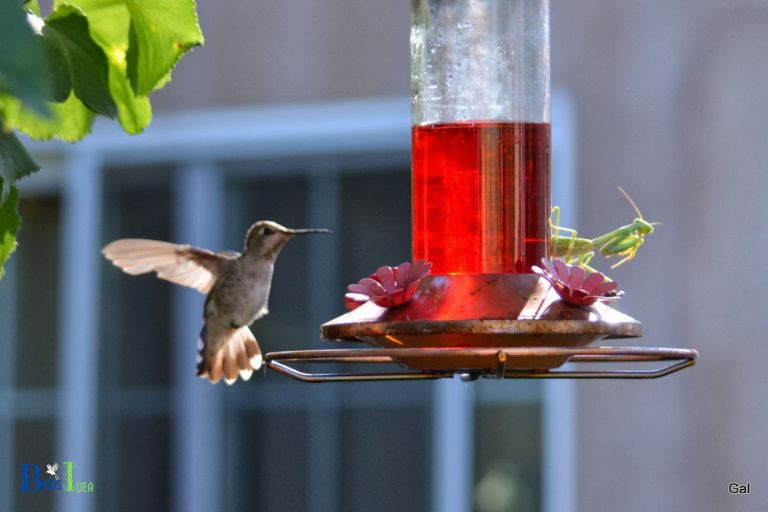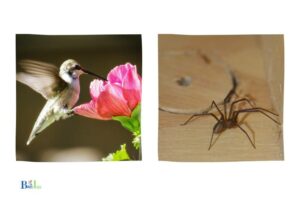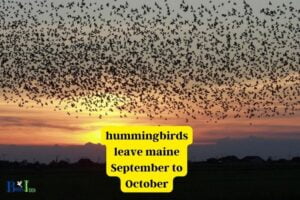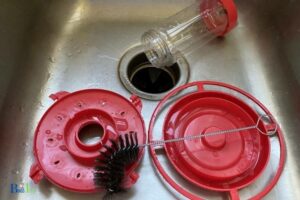How to Keep Praying Mantis Away from Hummingbird Feeders? 6 Methods!
Praying mantises can be deterred from hummingbird feeders by regularly pruning plants and bushes near the feeders, ensuring the feeder is positioned at least six feet off the ground, and using specialized mantis-resistant hummingbird feeders.
Praying mantises are predators that can harm hummingbirds. They are attracted to hummingbird feeders because they serve as excellent hunting grounds for small insects and sometimes even the hummingbirds themselves.
To protect these delicate birds, it’s necessary to deter praying mantises from the feeders. By taking these steps to deter praying mantises, it will keep hummingbird feeders safe and inviting for hummingbirds.
The best way to keep hummingbirds around is to make sure their food source is secure, and apply these deterrents to the feeders for the best protection.
6 Effective Methods to Deter Praying Mantis from Hummingbird Feeders
| Methods | Description |
| Use of Nectar Guards | These are small plastic nets that fit on the feeding ports of the feeder, making it difficult for praying mantis to reach the nectar. |
| Change Feeder Location | Praying mantises are less likely to invade a feeder if it’s in a location that’s hard for them to reach. Avoid placing the feeder near foliage or branches. |
| Feeder Design | Some feeder designs make it harder for praying mantises to access the nectar. For instance, feeders with a moat in the middle are usually more difficult for a mantis to navigate. |
| Use of Decoy Feeder | A decoy feeder can distract the mantis from your hummingbird feeder. Place the decoy closer to foliage or branches where mantises are more likely to be. |
| Regular Inspection | Inspect your feeder regularly to catch and remove any mantises before they become a problem. |
| Use of Insect Repellents | Some natural repellents such as peppermint oil can be used around the feeder to deter mantises. However, ensure the repellent is safe for birds. |
Exploring How to Keep Praying Mantis Away from Hummingbird Feeders

DID YOU KNOW
According to the University of Michigan’s Bird Houses Lab, hummingbirds consume up to twice their body weight in nectar every day.
Pray Mantises Deterrent From Hummingbird Feeders
Praying mantis are predatory insects that can cause harm to hummingbirds at a hummingbird feeder.
To deter mantis from feeders, there are several steps which can be taken:
- Place the feeder in a shady spot, as mantis are sun-loving insects.
- Hang the feeder at least 5 ft from the ground, or place it on a pole.
- Add a mantis guard, a cylinder of metal or plastic mesh, around the feeder.
- Clean the feeder regularly to remove mantis egg cases.
With the above steps, hummingbird feeders can be kept safe from mantis. Hummingbirds are important pollinators and it is important to ensure they are able to feed safely.
With a few preventative measures, mantis can be kept away from feeders.
Pruning Plants and Bushes Near the Feeders
Pruning plants and bushes near the feeders is important for a number of reasons.
- It prevents the plants from blocking access to the feeders
- It allows more light to reach the feeders and increases seed germination
- It eliminates potential hiding spots for predators such as cats
- It eliminates potential hazards from sharp branches and thorns

Pruning is best done in late winter or early spring when plants are still dormant. Dead branches should be removed first, followed by any overgrown branches.
Pruning shears can be used for larger branches and a pair of scissors for smaller ones. Taking care to prune just the necessary branches will help keep the plants looking healthy and attractive.
“Hummingbirds are built to fly. The flower’s part is to provide them nectar and safe resting spots.”
birdsidea
Positioning the Feeder At Least Six Feet Off the Ground
Positioning the feeder at least six feet off the ground is an important part of maintaining a safe and healthy bird environment.
This will prevent predators from accessing the feeder and potentially attacking the birds. It will also prevent the birds from coming into contact with other animals and potentially spreading disease.

There are several benefits to keeping the feeder off the ground:
- Birds are safer from predators and disease.
- Food is less likely to be wasted from being stepped on or dirtied.
- Smaller birds have an easier time accessing the feeder.
- Waste is less likely to accumulate as the feeder remains clean and dry.
Positioning the feeder at least six feet off the ground is a key part of creating a safe and healthy bird habitat.
Using Specialized Mantis-Resistant Hummingbird Feeders
Hummingbirds are beautiful and mesmerizing birds that often visit our yards and gardens. However, they can also be preyed upon by mantis.
To protect hummingbirds from such predators, specialized mantis-resistant hummingbird feeders can be used.

Here are some advantages of using specialized mantis-resistant hummingbird feeders:
- The feeders are designed with a wide-mouth opening that makes it difficult for predators to reach the food.
- The feeders also have an anti-drip feature that prevents the sugar water from spilling, thus reducing the chance of attracting mantis.
- They are made of durable materials so they can withstand the elements.
- The feeders have a perching area that allows the hummingbirds to feed comfortably.
- They also come in a variety of colors to suit the aesthetic of any garden or yard.
Overall, specialized mantis-resistant hummingbird feeders are a great way to protect hummingbirds from predators while still providing a safe and comfortable place for them to feed.
Making Decoys Near The Feeder
Decoys are an effective tool for duck hunting. Placing decoys near the feeder can be particularly useful in attracting ducks.

Here is how to make decoys near the feeder:
- Choose a spot close to the water and near the feeder. This will give ducks a sense of security and will encourage them to come closer.
- Place the decoys in a natural environment. Ducks will be more likely to land if they feel like they’re in their natural habitat.
- Place the decoys in a formation that will attract the ducks. A V-formation or a triangle formation is particularly effective.
- Be sure to add motion to your decoys. Ducks may be hesitant to land if they don’t see any movement.
- Keep the decoys clean and free of debris. Dirty decoys will be much less appealing to ducks.
By following these tips, you can make decoys near the feeder that will attract ducks and increase your chances of success.
Reasons of Keeping Praying Mantises Away From Feeders
Praying mantises can be beneficial to your garden by controlling pests, but they can also be a nuisance when they feed on birds.
Keeping them away from bird feeders is important for the following reasons:
- Praying mantises are predators and can harm birds. They feed on insects and small animals, including birds. Keeping them away from bird feeders will prevent them from preying on the birds.
- Praying mantises can be territorial and aggressive. When they are near a bird feeder, they may attack other birds and scare them away.
- Praying mantises can disrupt the bird seed supply. If they eat too much seed from the feeders, it can reduce the amount of food available for the birds.
- Praying mantises can be a distraction. If they are too close to the bird feeders, they may distract the birds from eating and make them more likely to fly away.
Keeping praying mantises away from bird feeders will help keep birds safe, and ensure they have enough food to eat.
Conclusion
Taking these simple steps to deter praying mantises from hummingbird feeders will security their food source and make the feeders a safe and inviting place for hummingbirds to rest and feed.
You should also avoid feeders that hang close to the ground, as this may make them more accessible to the mantis.






